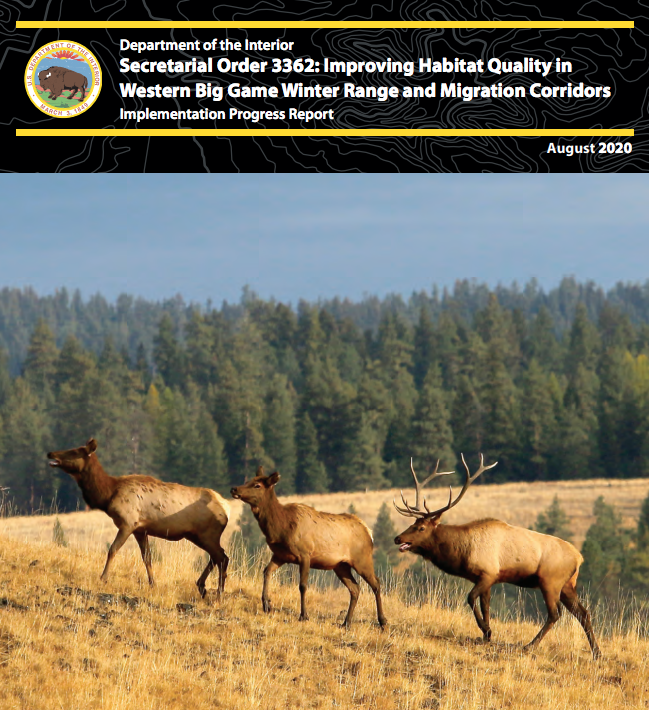
Wildlife Movement & Migration Committee
Elk Bull, Arizona. Photo Credit – Arizona Game & Fish Department
The establishment of the Wildlife Movement and Migration Committee was approved by the WAFWA President and directors in July of 2019. The committee’s members consist of state and provincial fish and wildlife agency personnel who have technical expertise and oversight of matters involving wildlife movement and migration. The group reports directly to the WAFWA board of directors. The committee’s approved Statement of Purpose:
“A forum where jurisdictions can share information, methods, and foster collaboration on wildlife movement and migration. The working group will also serve the important function of providing information and updates to the directors and consistent messaging to media and legislators on behalf of WAFWA.”
Spotlight
Secretarial Order: SO3362
Improving Habitat Quality in Western Big-Game Winter Range and Migration Corridors
On February 9, 2018, at an event in Salt Lake City, Utah, the Secretary of the Interior signed Secretarial Order 3362, “Improving Habitat Quality in Western Big Game Winter Range and Migration Corridors”. The Order has attracted considerable attention and created momentum for management and conservation of migration corridors and winter range.
The Order is focused on species under the management authority of state fish and wildlife agencies, so it directs the appropriate bureaus within the Department to engage western states collaboratively and cooperatively. More directly, the Order recognizes state authority to manage big game species. The Order is focused on conserving, enhancing, restoring, or improving the condition of priority big game winter range and migration corridor habitat. Ultimately, the habitat conservation activities resulting from the implementation of the Order will provide positive benefits to big game populations and numerous other wildlife species.
NEW
Fact Sheets
Wildlife Habitat Connectivity and Conservation
Fact Sheet #1
WILDLIFE HABITAT CONNECTIVITY AND CONSERVATION
All wildlife species rely on the ability to move throughout the landscape to complete their life cycles. During different parts of the day, season, or year, wildlife must move to access food and water, shelter, opportunities to mate, and favorable sites for raising young. The routes they use to make these movements can span anywhere from a small patch of forest to crossing multiple countries. Human and natural changes to the landscape can affect the ability of wildlife to move by adding obstacles, inducing changes in their behavior, impacting critical migration stopover sites, and increasing habitat fragmentation. Conserving these routes and maintaining habitat connectivity is important for the persistence of wildlife populations and for landscape health. READ MORE
Importance of Private Lands and Landowner Incentive Programs for Big Game Movement
Fact Sheet #2
IMPORTANCE OF PRIVATE LANDS AND LANDOWNER INCENTIVE PROGRAMS FOR BIG GAME MIGRATION
While wildlife are a public resource, private landowners provide important habitat for big game and other wildlife. Some big game species can spend a large portion of their lives on private land. Many migratory elk and mule deer herds live on high elevation public land in the summer, but move to low elevation winter ranges which are frequently dominated by private land. Because of their wide-ranging movements, habitat for big game is not managed by one landowner or agency alone. It requires stewardship across jurisdictions and landscapes. The continued existence of long-distance migrations and wide-ranging species is a testament to the current and past management of these lands. READ MORE
Resources
State Publications
Migration Matters: The migratory journeys of mule deer in Oregon (2023)
THE STORY OF MULE DEER MIGRATION IS A STORY OF WESTERN LANDS. Over thousands of years, mule deer have learned to navigate these complex landscapes and their dynamic climates. Each spring, many mule deer migrate to take advantage of rich vegetation, following the growth of young, nutritious plants to higher elevations and escaping the dry summer heat of the sage-steppe and mixed juniper woodlands below. The routes of these remarkable trips have been passed from generation to generation. Read more about their story (HERE).
Additional Resources
Wyoming’s Migration Initiative https://migrationinitiative.org/
US Geological Survey’s Ungulate Migrations of the Western United States: Volume 1 (pdf, 38.2MB), Volume 2 (pdf, 70.2 MB), Volume 3 (pdf, 46.9 MB), Volume 4 (pdf, 77.8 MB)

